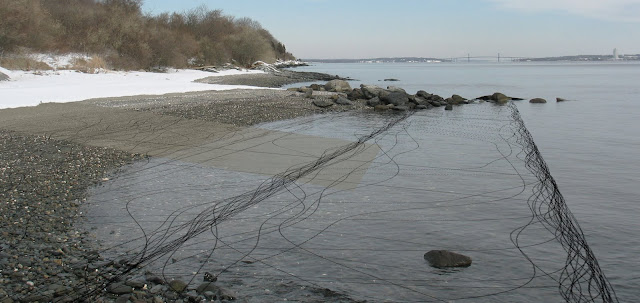appendices: glossary, bibliography, image credits
APPENDIX I: glossary
Contour: a continuous and generally unperceived indicator of an elevation; a horizontal section defined by the leveling of water.
Culture: the behaviors and beliefs characteristic of a particular social group; the sum total of ways of living built up by a group of human beings and transmitted from one generation to another; the total product of human creativity and intellect; also interesting to consider biologically in terms of to grow in or on a controlled or defined medium.
Dynamic: active; characterized by energy or effective action; changing; progressive.
Ecology: the science of the relationships and interactions between organisms and their environment; human ecology being the study of relationships between humans and their physical and social environments.
Ecotone: a transitional zone between two ecological communities; often a space with increased biodiversity due to the convergence of multiple communities.
Edge: a line or border at which two things meet; a brink or verge; a spatial and dynamic boundary.
Filter: to distill; one component of a three-dimensional, layered system; an active term for cultural and ecological design.
Fluid: a substance that is capable of flowing and that changes its shape at a steady rate when acted upon by a force tending to change its shape; changing readily; shifting; not fixed, stable, or rigid; understood both in terms of being aqueous and adaptable/flexible.
Frame: a structural reference; an expanding boundary; articulated space; particular to place and perception.
Hold: to remain; one component of a three-dimensional, layered system; an active term for cultural and ecological design.
Natural Process: a systematic series of actions existing in or produced by nature; a natural outgrowth or projection; the condition of being carried on; the act of natural forces; course or lapse, as of time.
Release: to free; one component of a three-dimensional layered system; an active term for cultural and ecological design.
Systems: a fluid, layered, three-dimensional articulation of relationships.
Terrain: the surface area of land considered by its natural features; a continuous topography; the relationship between contours; a connection of landform to its context.
Viewshed: an area of land, water, and other environmental elements as perceived from a fixed vantage point; viewshed implies a witness, often for aesthetic reasons, or with an eye toward conservation because of the natural beauty of the place.
Water: H₂O; seen through the lens of a varied understanding as a material, concept, surface, icon, system, resource, culture.
Watershed: an area topographically or hydro-geologically defined that contributes all the water flowing to a particular locally-defined area.
APPENDIX II: bibliography
Amidon, Jane. Moving Horizons: The Landscape Architecture of Kathryn Gustafson and Partners. Basel: Birkhauser, 2005.
Crosdale, William. A Guide to Rhode Island’s Natural Places. Narragansett: University of Rhode Island, 1995.
Curran, Francis. Prudence Island Circa 1895: Research & Cartography. Private publication, 1970.
Gali-Izard, Teresa. Los Mismos Paisajes/The Same Landscapes. Barcelona: Editorial Gustavo Gili, SA, 2005.
Hagan, Susannah. “Five Reasons to Adopt Environmental Design,” from Harvard Design Magazine. Boston: Harvard University Graduate School of Design, 2003.
Harmon, Katherine. You Are Here: Personal Geographies and Other Maps of the Imagination. New York: Princeton Architectural Press, 2004.
Hill, Kristina. “Shifting Sites,” from Site Matters. New York: Routledge, 2005. p. 130-155.
Knechtel, John, ed. Water: Alphabet City No. 14. Cambridge: The MIT Press, 2009.
Koppel, Tom. Ebb and Flow: Tides and Life on Our Once and Future Planet. Toronto: The Dundurn Group, 2007.
Koren, Leonard. Wabi Sabi for Artists, Designers, Poets & Philosophers. Berkeley: Stone Bridge Press, 1994.
Lin, Maya. Boundaries. New York: Simon & Schuster, 2000.
Lopez, Barry, ed. Home Ground: Language for an American Landscape. San Antonio: Trinity University Press, 2006.
Maytum, Charles. Paragraphs on Early Prudence Island. Private publication, 1976.
Meloy, Ellen. The Anthropology of Turquoise: Reflections on Desert, Sea, Stone, and Sky. New York: Vintage Books, 2002.
Mock, Freida Lee, dir. Maya Lin: A Strong Clear Vision. Santa Monica: American Film Foundation, 1995.
Munari, Bruno. The Sea as Craftsman. Mantova: Maurizio Corraini s.r.l., 1995.
Orr, David. The Nature of Design: Ecology, Culture, and Human Intention. Oxford: Oxford University Press, 2004.
Postel, Sandra. Last Oasis: Facing Water Scarcity. New York: W W Norton & Company, 1992.
Schäfer, Robert and Claudia Moll, ed. “Wasser Water,” from Topos. Munich: Callwey, 2002.
Simon, Anne. The Thin Edge: Coast and Man in Crisis. New York: Harper & Row, Publishers, 1978.
Stilgoe, John. Shallow Water Dictionary: A Grounding in Estuary English. New York: Princeton Architectural Press, 2004.
White, Stephanie. On Site: Water. Calgary: Canada Post, 2007.
APPENDIX III: image credits
Precedent Studies chapter:
Nathan Oliveira, Edge
Hiroshi Sugimoto, South Bay Drive-In
Mario Reis, Natural Watercolors
Gustafson Porter, Diana, Princess of Wales Memorial Fountain
Anne Lacaton + Jordi Bernado, High-Tide Pools
Tom Leader Studio, Coastlines
Kostas Manolidis, A River Park in Veria
Maya Lin, Systematic Landscapes:Bodies of Water, Water Line, & Blue Lake Pass
Site History chapter:
Le Rouge, Prudence Island
Charles Blaskowitz, Topographical Chart of the Bay of Narragansett
Francis Curran, Prudence Island circa 1895
Town of Portsmouth, Portsmouth Plat Map
Rhode Island Department of Environmental Management, Bristol & Prudence Quadrangles
Site Investigations chapter:
Rhode Island Geographic Information System, Narragansett Bay Geology: Sediment Types & Distribution
National Oceanic and Atmospheric Administration, Narragansett Bay
Rhode Island Geographic Information System, Rhode Island Bathymetry: Narragansett Bay
Rhode Island Department of Environmental Management, Prudence Island Wildlife Management Area South
Design Development chapter:
Hiroshi Sugimoto photographs collaged by Jessica Roundy with photographs and linework by Jessica Roundy
All other images by Jessica Suzanne Roundy
Subscribe to:
Comments (Atom)

